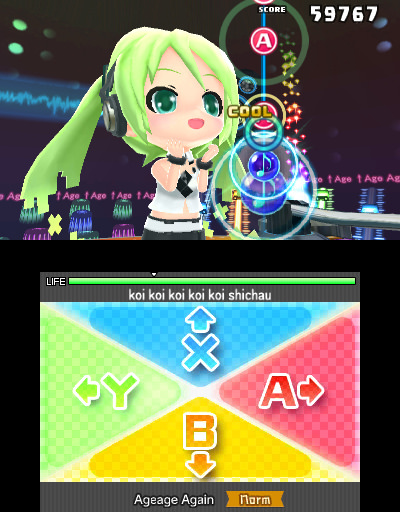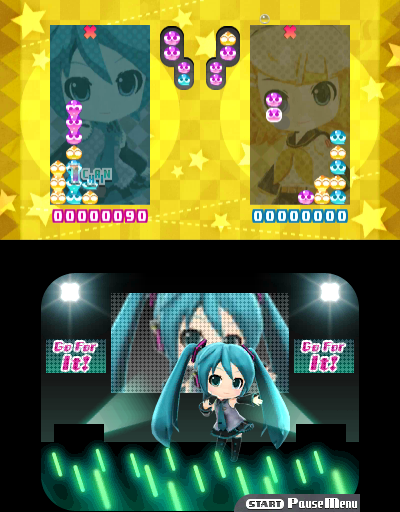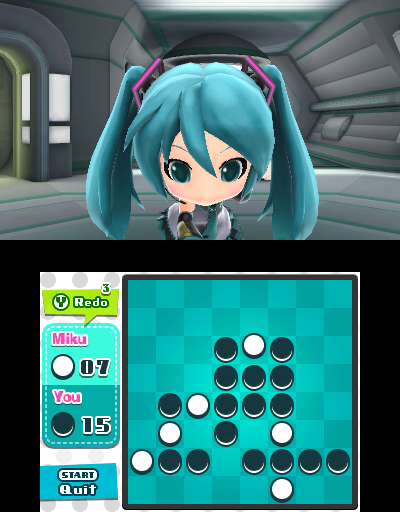Solid rhythm gameplay, coupled with a ridiculous amount of customization and Nintendogs-like life simulation
No Ievan Polkka song, and a disturbing lack of leeks
At this point, rhythm games are a dime a dozen. There’s mainstays, like Dance Dance Revolution or Guitar Hero; quirky ones, like Rhythm Heaven and Elite Beat Agents; and of course, weird fanservice-y titles like Senran Kagura: Bon Appetit.
You know what to expect. I know what to expect. You hit a button when the game tells you to, and hey presto!– get enough and you score! Maybe you get a high score. Maybe you impress somebody who’s watching. Maybe you unlock a new song, which is good, because otherwise you’d have to buy one as DLC. Rhythm games. What more can we do with rhythm games?
Well, apparently, a lot. See, Hatsune Miku: Project Mirai DX is a rhythm game. But unlike its cousins, the Hatsune Miku: Project DIVA games on PS Vita and PS3, Project Mirai DX isn’t just a rhythm game. It’s Nintendogs. It’s Tomodachi Life. It’s Style Savvy: Trendsetters. And, somehow, in its attempt to totally fill your life with its charm, it’s Austin Powers: Oh Behave.
(Don’t worry, the nausea will pass.)
If you’re already a fan of the quasi-real pop idol and her Project games, the gameplay should feel right at home with you. And even if you’ve never played a Project game, the core gameplay should be pretty recognizable to anyone who’s ever played Elite Beat Agents, or any rhythm game for that matter. Icons appear on the screen, and you have to press buttons, or tap/swipe the screen, in rhythm. (You pick whether you want to use buttons or the touch screen, though I prefer the touch screen because it makes me feel like Elite Beat Agents got a sequel.) Sometimes, you’ll have to rotate the Circle Pad or draw in circles. All the while, Miku and friends will be dancing around in a music video that you can’t help but ignore, because if you start watching, you stop winning. Fortunately, after you beat a song, you get to watch the music video in Theater Mode– a nice reward for your frantic tapping and pressing.

Project DIVA’s rhythm action returns with chibi-tacular Miku & friends.
It’s fun and and it’s adorable, and with 40 songs in varying difficulties, Project Mirai DX already surpasses a lot of its fellow rhythm titles. And there’s customization: you can change the voices in some songs, in case you want to hear something new. And with currency you earn after beating different songs, you can even change the clothes Miku and friends wear. All this ensures that while the gameplay may be old hat for a rhythm game, Project Mirai DX makes sure that old hat is presented incredibly well.
But Sega has billed Project Mirai DX as a “lifestyle” game more than just a rhythm game, and it’s easy to see why. At the outset of Project Mirai DX, you choose a partner, among Hatsune Miku and her friends. Boom! You’re in charge of that partner now. Your partner lives in the main screen, like a French bulldog in Nintendogs, so that’s who you’ll be hanging out with when you’re done tapping away.
Don’t worry: if you end up regretting your partner decision, you can pick someone else. But like with starter Pokémon, you might feel a little bad about it– because boy, will you be invested in your first one. When you pick a partner, you also choose a place to live (also swappable), from Japanese-themed locales to futuristic sci-fi hubs. With coins you earn through rhythm gameplay, you can buy furniture, clothes, and more, investing more and more into your partner and his or her particular living situation. You can even buy ice cream bars and cakes for your partner to eat, and take screenshots of the resulting brain freezes or sugar rushes. And of course, like any good parent partner, you can give your Nintendog partners an allowance, which they’ll spend on their own time, on stuff that they really want. It can be a little dating sim-y at times, but with the chibi art style, it’s definitely more Tamagotchi than Love Plus.


“Did you expect just a rhythm game? Sorry to totally exceed your expectations in every way.“
But it turns out Project Miku DX isn’t just a rhythm/music and friendship simulation game. There’s games within the game. You can play Reversi with your partner, for example, and the AI’s not so bad, either (or I’m just terrible at Reversi). You can even play Puyo Pop, in an incredible callback to one of Sega’s more niche IPs. Puyo Pop! Project Miku DX is full of charming bits like this, pleasant surprises that give the game a heaving helping of heart. “Are you having fun?” the game seems to ask. “Well, have more fun.”
At first glance, Hatsune Miku: Project Miku DX might look like “just” a fanservice game. And, let’s be honest, it is a fanservice game– but in more ways than one. There’s Hatsune Miku singing songs. There’s taking care of Hatsune Miku. And then there’s playing Puyo Pop with Hatsune Miku. Project Miku DX demands your attention even when you’d like to play something other than rhythm games, because there’s more than just rhythm here. That’s not just incredible for a licensed game. It’s inspiration for all the other ones.
Nintendojo was provided a copy of this game for review by a third party, though that does not affect our recommendation. For every review, Nintendojo uses a standard criteria.




 ShareThis
ShareThis






